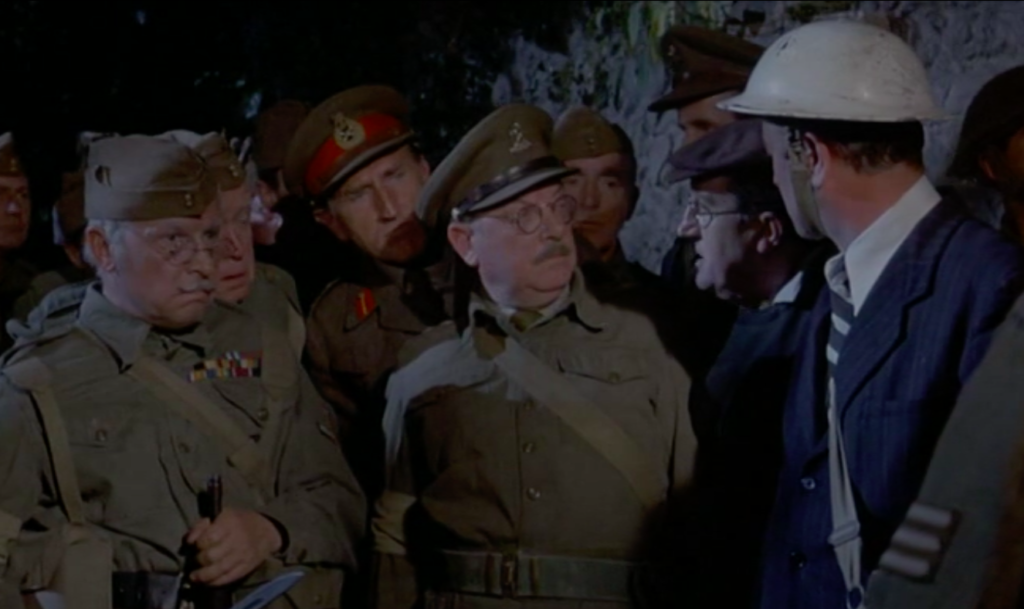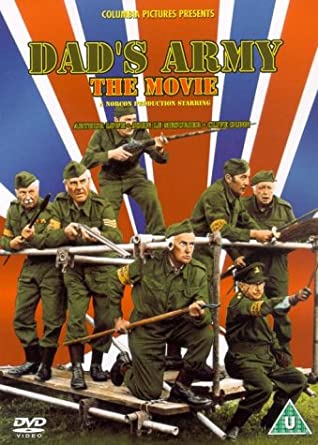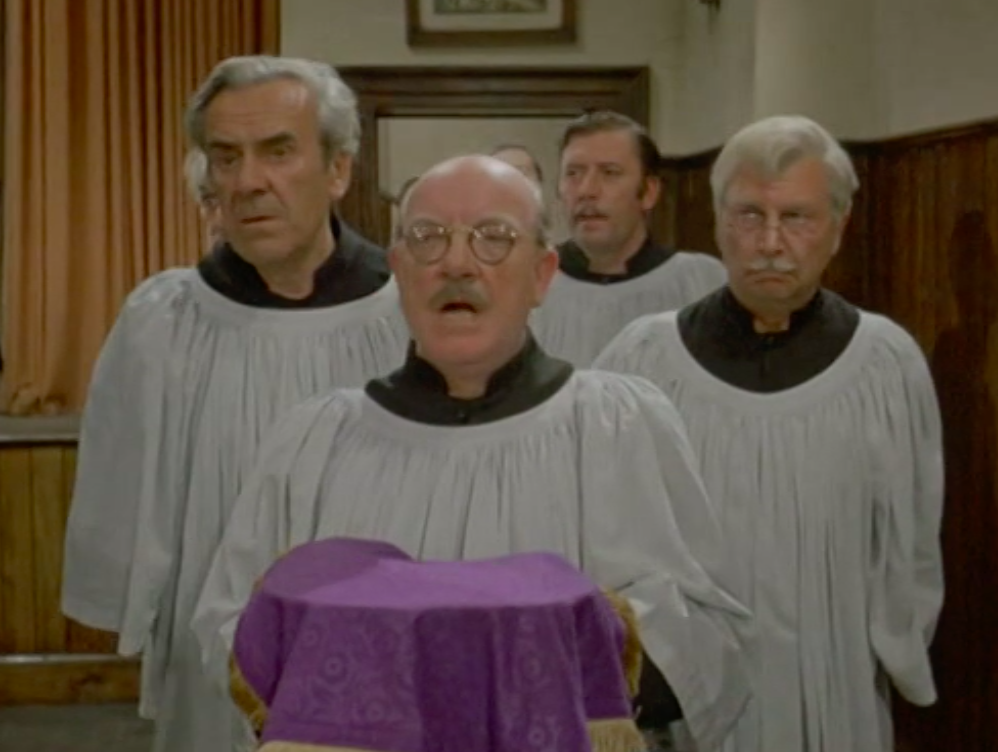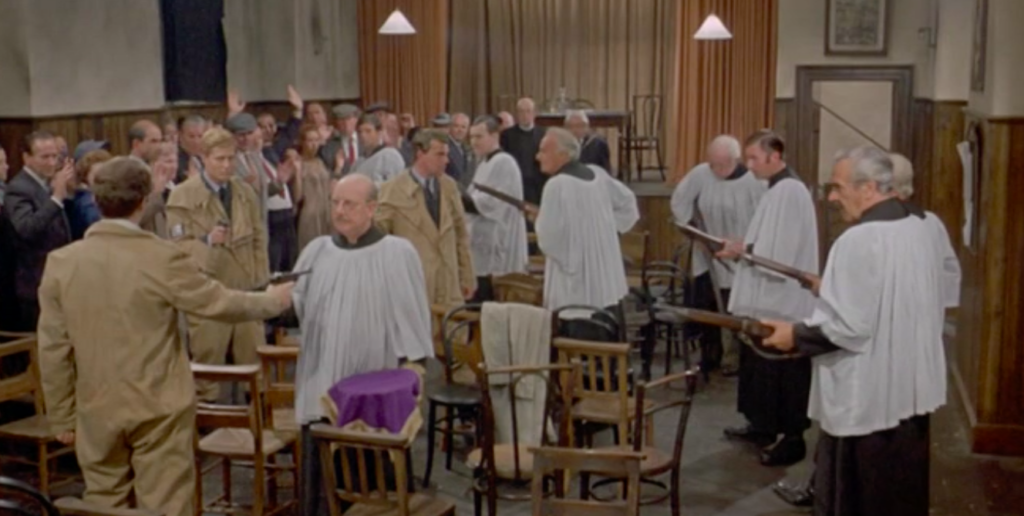
Dad’s Army is a British sitcom, produced by the BBC from 1968-1977. It tells the story of the UK’s Home Guard, an organisation of volunteers who were ineligible for military service due to their age or profession but who formed local citizen militias to protect Britain in the event of a German invasion during the Second World War. The long-running series was written by Jimmy Perry and David Croft, who both served in the Second World War for the British Army – Perry first in the Home Guard in 1940, then the First (Mixed) Heavy Anti-Aircraft Regiment of the Royal Artillery at Oswestry in 1943, before being sent to India; and Croft serving in the Royal Artillery in 1942 in North Africa, India and Singapore.

In 1971 a feature-length film was made as a spin-off from the sitcom, directed by Norman Cohen. Featuring the same cast as the regular series, it told the story of the formation of Walmington-on-Sea’s Home Guard’s platoon in 1940, and their endeavours at a training exercise. The scene I particularly want to highlight occurs near the end of the film, when a German aircraft has been shot down and the three men inside parachute to safety, before entering Walmington church hall, where a meeting is taking place to raise funds for a Spitfire. The Germans take everyone in the hall as hostages, including the mayor and vicar. The Home Guard Platoon then enter the building through the church crypt, dressed in choir robes and singing ‘All Things Bright and Beautiful’. Captain Mainwaring has a revolver hidden under a collection plate and confronts the German leader. The platoon reveal they have rifles under their robes, and the Germans surrender.


Can peace be seen in this clip?
This clip from the film is very interesting in portraying ‘pockets of peace’. Firstly, the film overall is very humorous, based as it is on the long-running sitcom. However, at this point in the film, there is a great amount of tension and fear for the civilians who are being held hostage. Jokes are still made however, with the characters changing the words to the hymn ‘All things Bright and Beautiful’: one character sings ‘Fraser get behind him, and I will get his gun’ and another replies ‘And I will take my bayonet and stick it up his…’, before being cut off by the German leader shouting ‘Halt!’. Thus, even in moments of major tension, humour is still used in the scene, turning a potentially serious situation into something of a joke. Although the characters themselves do not find this funny, for the audience watching it has this effect, dissolving tension as the characters plan their ‘tactics’ for disarming the Germans.
This dissolving of tension via humour then culminates in a more profound dissolving of tension, via disarmament. I picked this scene because it shows a brief moment of peace and conflict-resolution within a wider conflict, long-running – something which we have looked at in our research as ‘pockets of peace’. The Second World War is still occurring at this point, but for the individuals in the church, the focus is on the moment itself, when the Germans are disarmed. For them at this point, the immediate conflict is over, creating a moment of calm and relative peace. It is a reminder that armed conflicts are made up of many local and personal ‘peaks and troughs’ of tension, danger, fear and problem-solving. The disarmament of three Germans who were threatening violence to civilians feels like a small victory and a restoration of order in a much larger war.
Peace is also portrayed as justice and the righting of wrongs in this scene. The ‘bad’ Germans, who have taken the civilians hostage and are threatening to kill them, are defeated by the ‘heroes’ of the UK Home Guard, whose inexperience as soldiers is more than made up for by their ingenuity and bravery. Dressed in choir robes, they look the antithesis of soldiers, but they embody both civilian vulnerability and military values. The courage and determination they show, in mounting a rescue themselves rather than waiting for the regular army and in facing down Germans who are holding pistols to their heads, marks them out not just as ‘good’ but also as ‘heroic’. This promotes habits of visualising peace which connect it to ‘victory’ and the triumph of ‘good’ over ‘evil’. Although this brief episode represents only a minor conflict resolution – a small pocket of peace – in a much longer war, it reflects wider trends in the representation of Britain’s defeat of Germany during WWII, which prevail to this day: the amalgamation of ‘peace’ and ‘victory’ manifested for example in phrases like VE Day (Victory in Europe Day). Of course, the idea that peace comes or is complete the moment that disarmament happens or a ‘victory’ is achieved is very misleading: any visualisation of conflict resolution or the laying down of weapons that does not consider aftermath or ongoing challenges is necessarily incomplete.
Finally, the choice of dressing the characters up as church choir singers is interesting in its communication of ideas of peace through religious symbolism. It is undeniable that religion has been at the root of many conflicts; but at the same time many religious movements, including Christianity, have also been viewed as inherently peaceful. By dressing up as choir members, the soldiers of the Home Guard wanted to communicate to the Germans that they posed no threat; and the lyrics of the hymn – ‘All Things Bright and Beautiful’ – also conveyed peaceful vibes, via images of nature and celebration of its beauty. There is an incongruity in the scene, as the peaceful practice of hymn-singing and men wearing clothing that is not associated with violence disrupt a tense, hostage situation. But their peaceful demeanour is simply a cover, of course – a ruse, to hoodwink the Germans and force their surrender, which leads (ironically) to conflict resolution.
There is a lot of nuance, then, in visualisations of peace in this short clip from the Dad’s Army film, with clichés and stereotypes of things that ‘look’ peaceful being exploited to bring about disarmament, a small victory, a brief pocket of peace. The scene features triumph, conflict resolution, a rescue, and peace imagery of religion, but does it show true peace itself? It certainly raises interesting questions about how ideas and experiences of peace can become more complex – and even re-imagined – during a conflict, by depicting a small moment of conflict resolution in the context of a much wider war.
What do you think?
- How have perceptions of peace and peace-making evolved from the 1970s?
- How ‘British’ or culturally-specific would you say the images and ideas of peace, war and conflict resolution are in this clip from the Dad’s Army film?
- What role can humour play in helping us explore people’s experiences of war and peace? Is humour always appropriate? Can in sometimes reinforce stereotypes rather than encouraging exploration?
- How might pockets of peace in a conflict shape people’s experience of the wider conflict around them? Do our habits of narrating pockets of peace differ from how we imagine or depict peace-building at the larger scale? How might visualisations of pockets of peace influence attitudes or approaches to wider peace-building?
If you enjoyed this item…
You might also enjoy ‘The Magnus Archives‘, ‘Pockets of Peace in Ukraine: care through music‘, ‘Pentagon Peace Pals‘ and items with the tag ‘Depicting Peace‘.
Claire Percival, April 2022
If you are interested in reading more, you can do so here:
https://www.traditionalmusic.co.uk/hymn-lyrics/all_things_bright_and_beautiful.htm
https://www.forbes.com/sites/lizadonnelly/2013/12/02/can-humor-be-a-factor-in-peace/
https://www.bbc.co.uk/programmes/b007tlxv